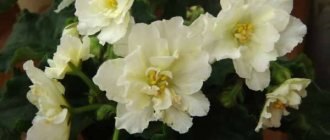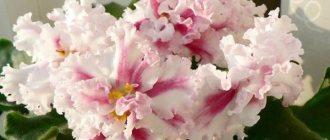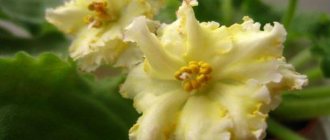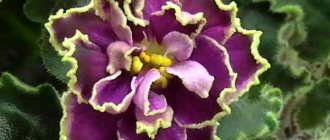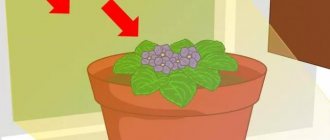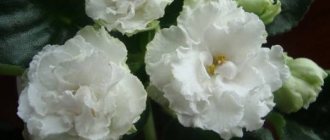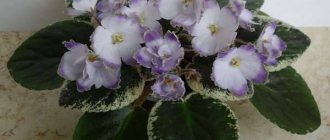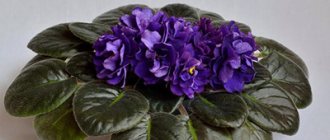Sorry to disappoint you, but black violets do not exist in nature. In the article we have prepared the TOP 10 popular varieties of dark violets of foreign and domestic selection, as well as a photo selection of varieties with darker flowers. Look and enjoy their beauty!
The darker color of flowers always attracts attention, sometimes even from people who are indifferent to this flower, and violets are no exception.
The dark tones of these flowers are combined with the beautiful shapes of the flowers, as well as the color and shape of the leaves. The resulting composition is mesmerizing.
Many flower growers, having seen this beauty, can no longer abandon the thought of buying these varieties, although there are not many of them, they are in great demand.
Well, almost black violet Dark Night of The Soul
Speaking of almost black varieties, Dark Night of The Soul cannot be ignored.
A beautiful, uniform, symmetrical, semi-miniature rosette that molds itself. The leaves are variegated, rounded, and quite large. The peculiarity of the variety is that the leaves are spoon-shaped, the edges are slightly curled upward. The color of the leaves is variegated, medium green with white.
The flowers are wine-black, terry overalls with a coral-red reverse. On the bud, the half-open flower is almost black and as it opens it acquires a red tint, more like a beetroot.
Important! This is the only variety Macdonald developed outside of the Mac series.
Violet Natalie description and characteristics
Violet Natalie: photo
Violet Natalie was bred several years ago. However, in fact, calling a violet a violet is not entirely correct. These plants are actually Saintpaulia, but due to their similarity with another type of plant, this crop is popularly called violet. The Natalie variety is a large-flowered crop, the flowers have a double appearance, the rosette of the plants is always symmetrical and well-formed. The foliage is red on the inside and dark green on the front. Usually, for the first time, Natalie’s violets do not form double inflorescences, but after the second and subsequent flowering, the doubleness appears more and more strongly.
TOP 10 varieties
Among all the black varieties, the ten most popular ones can be distinguished; they are distinguished by their richness of color, beauty of shapes and leaves. Each of these varieties has its own characteristics, and each of them is beautiful in its own way.
Mac's Black Pearl
The rosette is semi-miniature, the leaves are small, the cuttings are slightly elongated. The leaf is round, medium green, serrated, the edges are slightly curved down.
Despite its compactness, the rosette is sloppy and tends to lift leaves; To eliminate the problem, a fairly long daylight hours is required. Green grows slowly, rosette up to 17 cm.
The flowers are simple nuisances, small, up to 2.5 cm, bloom almost continuously, the peduncles are elongated and erect. The color of the flowers is almost black, with different lighting designs having a white, blue or burgundy-purple pencil border around the edge of the petals.
Each bud slowly opens and lasts up to 2 weeks, then gradually, imperceptibly fades, turning into a dried flower right on the peduncle.
Apache Midnight
Diversity of foreign selection. The ceiling rose is large, more than 30 cm, the size is obtained due to the size of the metal plate. The leaves are variegated, dark green with white-pink, slightly spoon-shaped.
The flowers are semi-double, medium-sized, pansy-shaped. The color is purple-burgundy, very dark, close to black. There is a thin white border along the edge. The flowering is quite abundant, the cap is small, there are 2-3 flowers on the peduncle.
The variety is slow-growing; cuttings usually have few pups, 1, 2, sometimes 3. The first flowering can last up to a year; on average, individuals are one and a half years old.
This variety is recommended to be replanted more often than others, but it is strictly forbidden to overwater.
Important! The white edge and light parts of the leaf look best in cool areas with slightly dim light.
Mac's Black Uhuru
A semi-miniature bush of irregular shape, leaves of different sizes, up to 17 cm in diameter. The leaves are round, very textured, all with tubercles and with clear yellowish lines above the veins, swamp green in color. The leaf blades are large, and the cuttings are shortened.
The flowers are large, like semimino, very double, like small roses. The color changes as the bud blooms, at first completely black, then increasingly acquiring a purple tint, the brightness of the flowers depends on the lighting.
The peduncles are short, strong, with 3-5 buds on each. It blooms for a long time, with a beautiful bouquet from the first flowering.
Important! It is very demanding in terms of care, it is important to follow all the nuances, otherwise the plant will easily die. When breeding, it produces many young and often forms stepsons on the bush.
Purple Passion
Variety of standard sizes. The leaves are large, dark green, slightly wavy. The rosette is quite loose, the leaf cuttings are long and strong. The shape of the leaves is round, with a pronounced base.
The flowers are very double, with a pronounced wavy edge and are large in size. The color of the flowers is dark purple, almost black with proper care. Towards the edge of the petals the color is darker, along the edge there is a pronounced white-green flounce.
AV-Noble Rose
Saintpaulia is a standard size, the rosette is fairly uniform, horizontal, and tends to slightly hug the vase of leaves. The leaves are light green, slightly elongated, pointed at the ends, with fine teeth along the edge. The leaf cuttings are of medium length and do not spoil the appearance of the rosette.
The flowers are large, quite double with a wavy edge of the petals, and their shape resembles a strongly open rose. The color of the flowers is burgundy-black, changing towards the light as they bloom.
AB-Inkheart, sports
Large grip on the border between standard and large. The leaves are very large on small cuttings, intense green in color, with a noticeable network of capillaries and a wavy edge. The leaves tend to grow in different directions, sometimes breaking the horizontal rosette.
Terry's flowers, unlike the original AV-Ink Heart variety, are even darker. The color of the petals is purplish-black with a light green, pencil-like outline and slight ripples along the edge.
AN-Black Tulip
The grip is standard size, slightly clumsy. The leaves are smooth, shiny, dark green. Spreading the plaque, the flower stalks gradually rise, scattering rosettes around the perimeter. Usually produces three buds on each peduncle.
The flowers are small, bell-shaped, close at night and open during the day, but not completely. The color of the flowers is dark purple, often close to black. The variety may have coral, fancy spots, but this is not necessary.
During the flowering process, the color gradually changes from dark to lighter, with the center of the flower always darker than the main part.
LE-Demo
The bush is of a standard size, symmetrical, easy to form, and can slightly hug a pot with leaves. The leaves are variegated, rounded, with slight wavy and fine teeth along the edge.
The flower stalks are strong, there are usually a lot of them, but the flowering is not very abundant, very often a small bunch blooms. The flower is medium-sized, double, the petals are slightly curved outward.
The color of the petals is very rich, dark blue, almost black, darker towards the edges. Along the slightly wavy edge is the point of a pencil.
RS-Milord
The rosette is medium-sized, flat, with fairly large leaves. The leaf is round, slightly curled along the edge, dark green in color. The bush forms well on its own, but with insufficient lighting it can lift the leaves a little.
The flowers are incredibly coloured, shaped like a simple star with a wavy edge, a bit like a bell, but with separate and more open petals.
The color comes with a gradient from the center to the edge, where the center is purple-black and the edge is completely white. The ratio of darkness and light in a flower depends on light and temperature; the warmer and brighter the place allocated to the flower, the larger the dark part.
AE-Witching Night
The bush is uneven, the leaves tend to curl and lift, and are medium in size. The leaf is dark green with a wavy, rounded edge, rather large on a short handle.
The flowers are quite simple in shape - round stars with small ripples along the edge. The color of the petals is dark purple, darker towards the edges, often reaching black. Along the edge there is a light green and white pencil border.
The peduncles are tall, and therefore flowering with a cap is almost impossible; usually 3-4 buds bloom on one peduncle.
Violet Natalie: care
Violet Natalie: photo of the variety
It is best to plant Natalie violets on soil rich in nutrients and microelements; moisture in the soil should not stagnate, as this often causes violets to rot; however, plants do not develop well even without water, so the watering regime must be adjusted optimally. Typically, violets of the Natalie variety are replanted annually, using new pots and new soil. If you prepare the soil mixture yourself, be sure to add some peat, vermiculite and moss to the garden soil. The soil should not be too acidic. It is also impossible to plant violets in large pots; the container for planting should be wide enough, but shallow. If the root system of the violet feels too spacious in the pot, then inflorescences may not form for a long time. Drainage is usually placed at the bottom of the pot; small pebbles and stones are used for this, but it is not recommended to place expanded clay in the pot, since this substrate makes the soil too saline. Dust often collects on the surface of the leaf blades, as violets breathe through this pile. But it is best to clean the leaves using a dry method; if you spray the foliage, you need to do this very carefully, since plants rot from excess moisture. Flowers can be watered in different ways. It is best to place pots of violets for some time in special trays with pebbles and water. Within half an hour, the plants are usually saturated with moisture, which means the pots can be sent back to the windowsill. You can also water Natalie’s violets with a watering can, but it must have a long spout; this is the only way you can water the flowers, avoiding water getting on the foliage and shoots. As you know, violets begin to rot due to excess moisture. For irrigation, it is better to use warm, settled water. If we talk about lighting, it is best to grow violets on windowsills, but the light should be dim and diffused. In the summer, it is recommended to shade the plants for a while to prevent the foliage from turning yellow and getting burned. If you notice that the shoots have become thin, this indicates insufficient lighting; violets of the Natalie variety need to “bathe” in the sun’s rays for 12-16 days. If you have a problem with lighting in your room, then purchase a special phytolamp; you will definitely need it in winter, since plants especially need light during this period. Violets are usually fed with liquid fertilizers, which contain large amounts of phosphorus. It is best to combine fertilizing the soil with watering.
